The ESEE Pinhoti is a friction folder knife designed by Shane Adams and manufactured in the US. It is a relatively new knife introduced at the end of 2022 at the Shot Show. It is a very capable friction folder with good looks and easy to carry size.
ESEE Knives makes knives and survival gear in the US with a focus on hard use survival and camp gear. They offer fair warranties and has a loyal customer base. ESEE has recently branched out into producing folding knives, and Pinhoti turns out to be a really good one.
The name Pinhoti came from the trails that wind through the Appalachian Mountains called the Pinhoti. It was named so because it was designed to be used in mountainous and outdoor activities like hiking, fishing, camping, hunting, etc.
The company also produces axes and cleavers, and is known for its no-nonsense affordable field knives for military, law enforcement and special operations community.
ESEE Pinhoti Review

ESEE Pinhoti is a friction folder by Shane Adams, the marketing manager and utility player at ESEE. It is 8.25” long and features a 3.25” drop point blade with a scandi grind and an extended tang. The handle is 5.75” long featuring brown Micarta and weighs 3.8 ounces. It also comes with a high-quality leather sheath.
Pinhoti is a versatile camping knife and has a mostly neutral shape and is easy for the hand to lock in.
Key Specifications of Esee Pinhoti
The Blade of ESEE Pinhoti

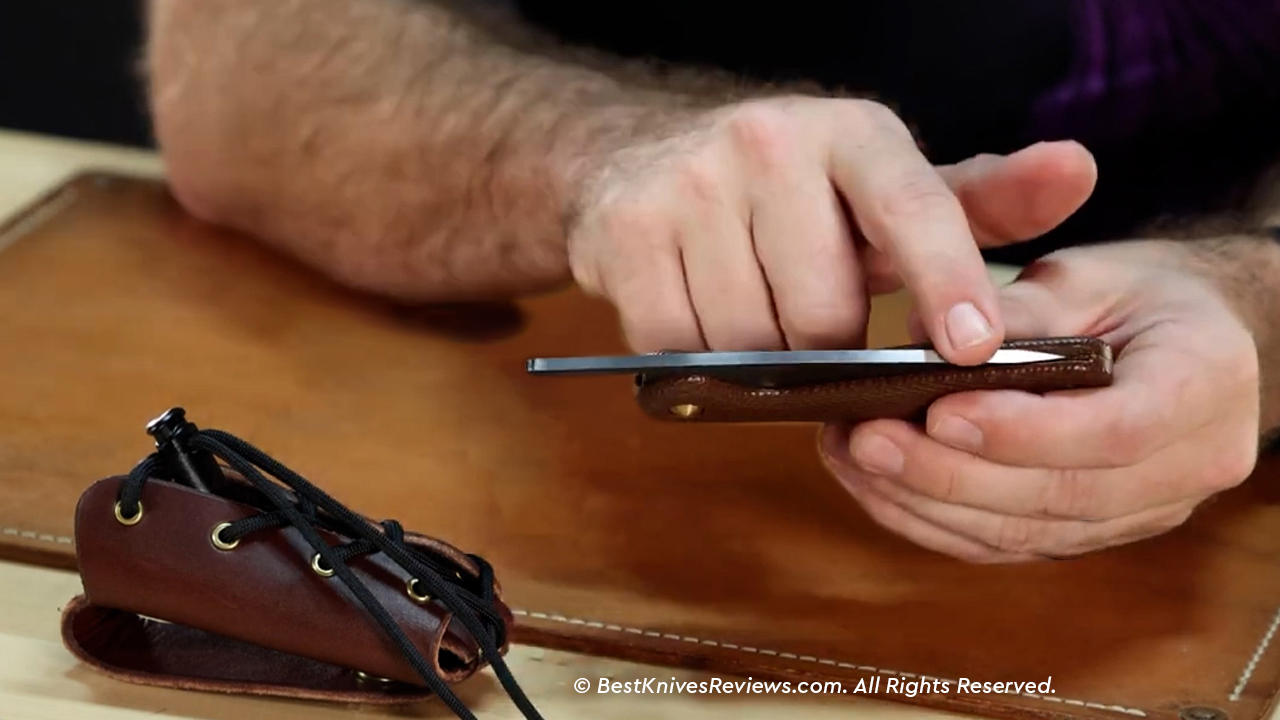
The Scandi-ground 1095 high-carbon blade with a 90-degree spine for firestarting makes the Pinhoti a survival knife that is as good and tough as a fixed-blade knife, except portable. The blade thickness of 0.12” definitely makes it a razor-sharp knife with a 3.25” cutting edge. That means great edge retention and holding, followed by the black stonewash finish, making the blade spotless.
The Scandi grind is especially notable with almost straight spine. The blade placement is more useful than the blade length. It is in a more angled position with the tang hanging out a bit and braced against the palm, which is unique because most knives do not have this capability.
The grind is also good for making feather sticks, and the tang works well to get sparks off on a ferro rod. Although when the knife is close with the spine protruding out, it may look uncomfortable, but also feels more natural as a fire-starting tool in your camping gear.
ESEE spent quite a bit of time on the knife’s stop pin. It sits on a pin that is on the inside, so that you can get a nice clean top without getting a hot spot. The stop pin in perfectly placed to keep the blade neatly aligned in closed and open position. If you move the blade, you can see where the tang is shaped to fit around in various positions. It is the attention to detail that made it so.
The blade however, lacks a sharpening choil. It compensates this with a break in the handle just below the spine. It allows you to really grip the handle, and the stop pin helps too. But it gets tricky to hone and sharpen the edge all the way to the bottom. But if there was a sharpening choil it would have interfered with chest lever grip. So it could be intentional.
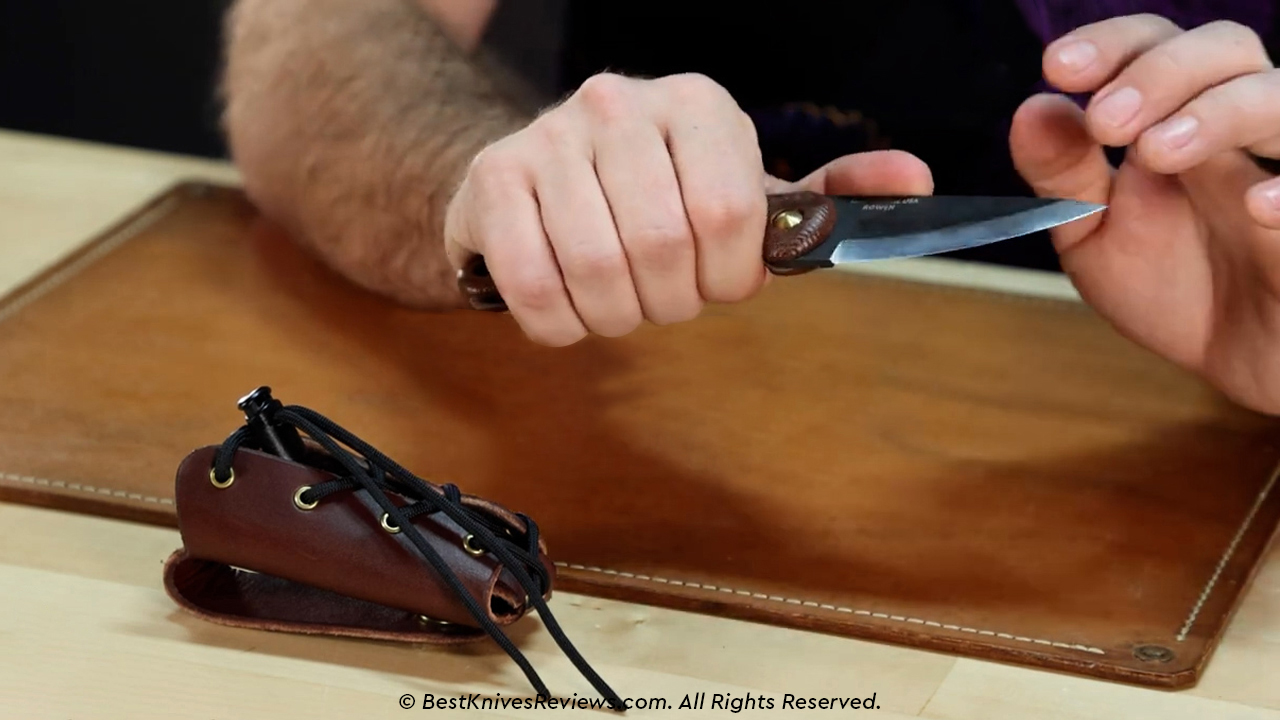
The 1095 alloy steel with its high carbon content makes it tough and hard. It contains 0.95% carbon, along with manganese, phosphorus and sulfur. Together, these elements add wear resistance and edge retention. The stonewash finish further adds to the corrosion resistant properties.
The 98% iron in the 1095 is what adds bulk and weight to the steel and the knife. The manganese adds brittleness and hardness and prevents decarburization during heat treatment. The phosphorus improves the machinability and corrosion resistance. Lastly, sulfur works with manganese to enhance machinability. It uses manganese sulfides to prevent deformation.
The Handle of ESEE Pinhoti
Most friction folders and slip joints are not as ergonomically friendly and safe as the ESEE Pinhoti. The ergonomics of the tang on this friction folder is remarkably done.

The brown Micarta looked a lot like a polished wood surface. It has a nice textural finish that also feels like wood, and the 3D scales have excellent palm-fitting shape. It took 8 to 9 3D printing models and three years to get to this point. SO needless to say, the scales were perfected precisely as intended. During this time, ESEE also released its 3D handles, which morphed from the traditional flat scales to the 3D scales. The morphing went a long way to making this handle as comfortable as it ended up to be.
Adam also paid special attention to the grip of the handle. He derived from the primary monkey or fist grip with a reverse chest lever, so it has the scallop for high leverage cut to do the reverse chest lever.
The scallop is well-lined in practice on this knife, so the index finger’s pad can nestle into it while you grip around the ricasso for a chest lever. This results in a chest lever grip with no hotspots. It was made to be comfortable for prolonged use, and for larger hands. But it actually turned out to be not so small-hand friendly in practice by those who had small hands. For average-sized hands, it feels incredibly comfortable and you can easily switch from a gorilla grip to a canted grip and a reverse chest lever. The inward curve also helps with a secure grip to nestle into for chest levers. The texture of the Micarta itself works as a jimping. Although, the jimping on the spine of the blade would further elevate a comfortable hold. The curve facilitates a strong canted grip where the index finger grips the bottom of the curve while the thumb rests along the spine. It keeps the blade in place while pushing along the knife.
You can also comfortably pinch up the blade by taking advantage of the height, and the tang gives enough leverage when you rest it in the palm.
The Sheath of ESEE Pinhoti
The leather sheath of the Pinhoti feels too bulky on the belt, but overall light and draws the knife smoothly. It also has a paracord wrap that allows you to wrap some lightweight tools and gear.

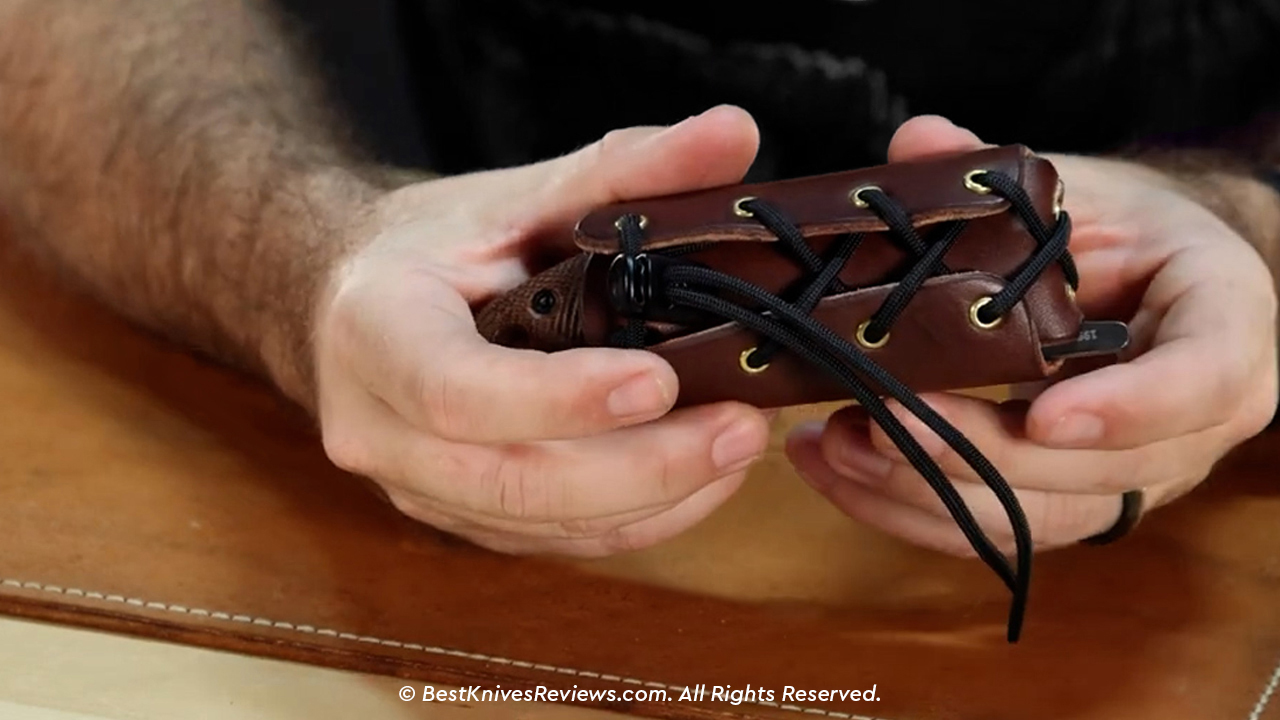
But once you do try putting some tools in, it gets even bulkier without running through the paracord. It is good but adds steps to getting the extra tool in your hand. The ferro rod is a good option, as they come wrapped up in their own paracord. It makes it easy for the tools to slip on to the Pinhoti.
You can also replace he cord with a thin rope or strap of leather and hang things on it. Although, that would add more weight on it, but dangle multiple tools together. If you add a little carabiner, you would not have to string off all the tools to fetch the ferro rod and the Pinhoti.
Experiencing ESEE Pinhoti in the Field
The ESEE Pinhoti is a phenomenal knife that worked exceptionally well in the field. Not only was it one of the best friction folders we have dealt with, but it also performed cutting tasks flawlessly. The fewer moving parts of the knife means it is able to stay open with its extended tang and lets you slice and dice quickly. With no locks or springs, Pinhoti makes for an excellent folding knife that relies solely on the handle’s friction against the extended tang.
The Scandi grind succeeded in making some nice feathers, and the tang works double time to strike a ferro rod. It is actually one of the easiest knives to use when it comes to starting a fire, which is great when you go camping and mountain climbing.
The designer, Shane Adams himself is an avid adventurer. That means grip was really important to him when designing this knife. And he delivered after years of attention to detail. No matter how you hold the knife, whether you use gloves, sweaty, oily, or dirty hands, this handle does not give way. It provides a perfectly comfortable grip whether you choke it, hold it from the back, or use the jimping for slicing and dicing. You can also use it for extended period without hassle.
But the absence of the sharpening choil makes it harder and longer to sharpen. You may use it for a long time, but good maintenance will go a long way on the Pinhoti.
The cutting edge seemed of be of great use, and was able to cut through pipes, ropes, cardboard boxes and even thin paper. The blade stock is razor-thin, so you can also use it for your everyday tasks. And although the blade may feel small, it delivers on whatever cutting task you throw at it.
We even spent hours cutting up cardboard boxes and the hand never even cramped up. The curve in the handle really helps with a smooth and nice grip. The tang is able to give the hand leverage when using the friction to close the knife. Although, it may be easier to do so if you have large hands. The thumb is easily able to reach the tang and move the blade along all the way out.
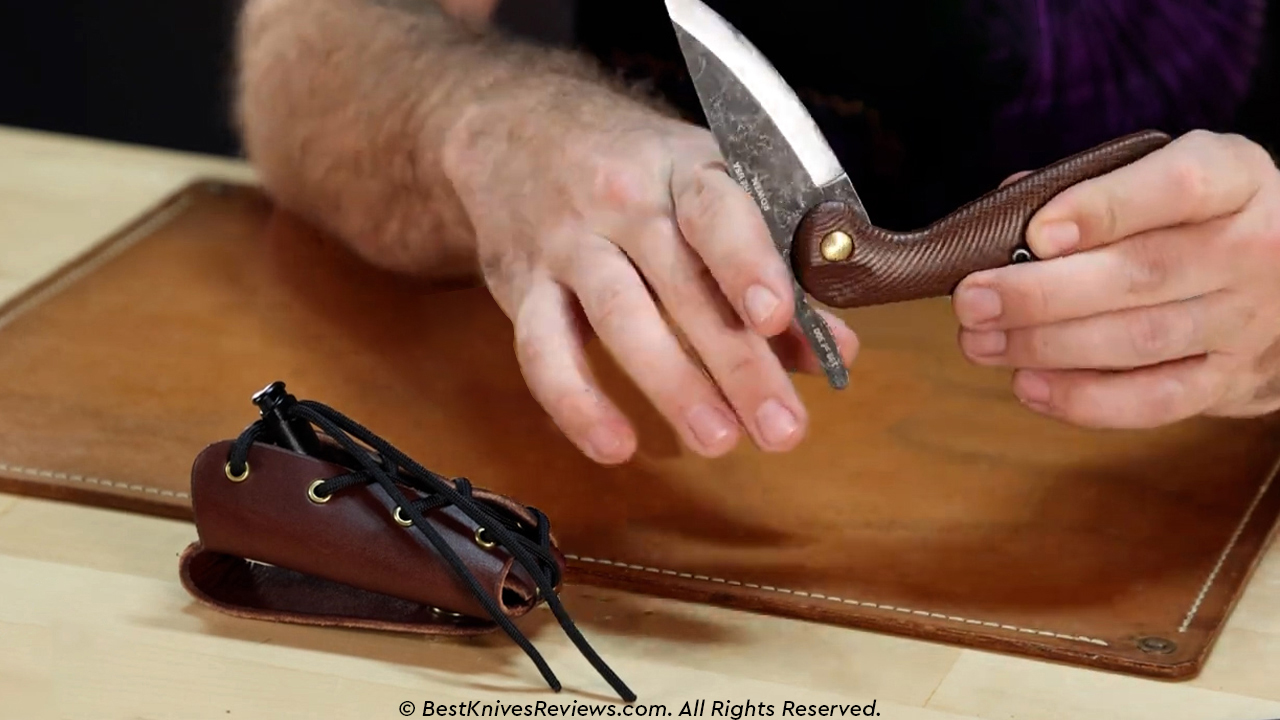
The stop pin is also very well-placed and easily inverts the blade. It is one of the best detailing on the knife that is also very practical.
The Pinhoti is not designed to be a batoning knife. It may show significant damage if you try to do so. But the Pinhoti has a failsafe in it that replaces the brass pin. But it is better not to do the batoning to begin with.
The sheath carries well and you can hang other tools on it. It does feel bulky but not awkward. It may feel like jingling when you are walking, but it is easy to carry nevertheless. You can also easily strip off the Pinhoti and other tools pretty quickly when need be.
Pros & Cons of ESEE Pinhoti
PRO’s
Con’s
Comparisons
ESEE Pinhoti vs Svord Peasant
If you are looking for good friction folders, then Svord Peasant is a close second, except it is much cheaper than the Pinhoti. It is much smaller with a hook at the end of the blade tang that offers unique options when it comes to holding the knife. But it is capable of carrying out the same tasks as the Pinhoti.
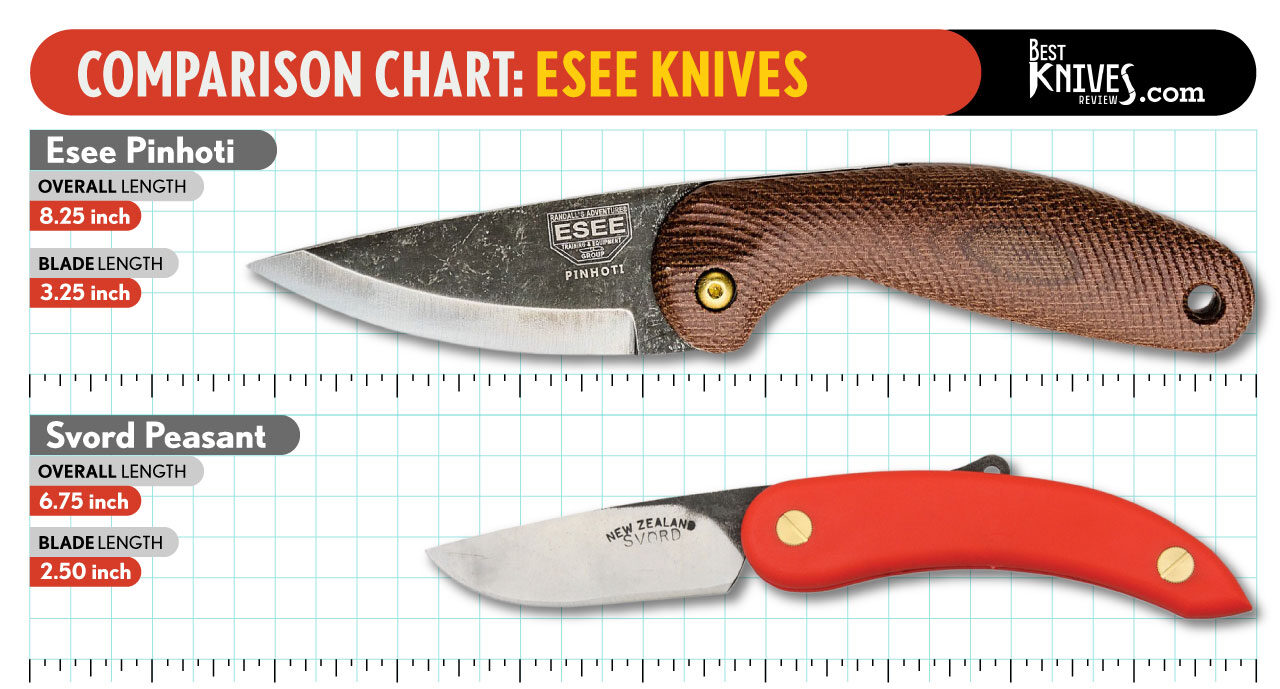
It does not come with a high-quality leather sheath, and does not have as good fit and finish as the Pinhoti.
Both are bushcraft knives, but the ESEE Pinhoti delivers the value for money well.
ESEE Pinhoti vs Fox Knives Dragotac Piemontes
The Dragotac Piemontes is a great friction folder that also costs less than ESEE Pinhoti. It has wooden ziricote scales and comes with a leather sheath. But the blade is of Bholer N690, but the Wharncliffe does not make it easier to use it in the forest or on mountain adventure.

The design of the Dragotac Piemontes however, is good. It has great ergonomics. However, not as good as the Pinhoti’s. The Pinhoti goes an extra mile on the ergonomics. It also has a good edge retention that stands between a hard steel and a flat grind.
Conclusion: ESEE Pinhoti Fixed Blade Knife Review
We found the ESEE Pinhoti review to be beyond positive. Its high price totally justifies the knife’s design, ergonomics, usability, functionality and performance. The Scandi grind is unusual, but extremely helpful. The ergonomics of the Micarta are off the charts. And the sheath is of high-quality leather that can also be multipurpose. It also weighs less, although it may feel bulkier on a thin belt.
The only problem with the Pinhot is that it may not work well in a small hand. Nevertheless, it works great regardless and provides an extremely comfortable hold.
The Pinhoti also passed its field test with flying colors. You can rely on it to carry along with your backpack gear and use the ferro rod to start a fire very easily.
When compared with other friction folders, the ESEE Pinhoti comes on top. Although it still costs more than other friction folders on the market, but that is because it is new, high in demand, and reliable.